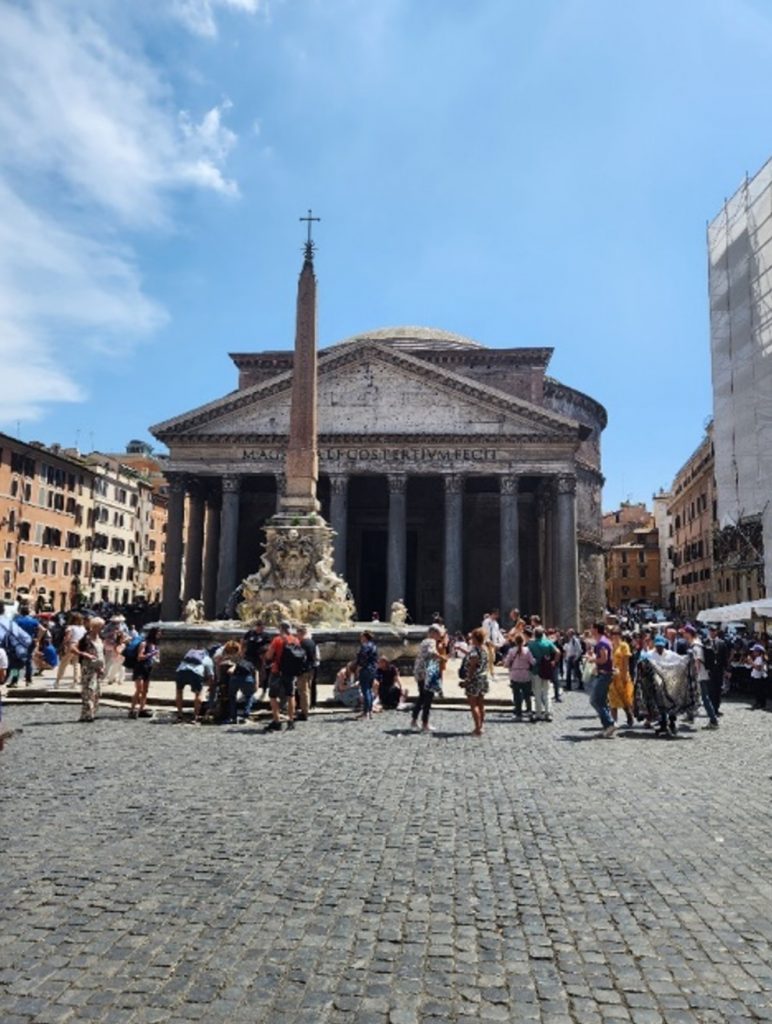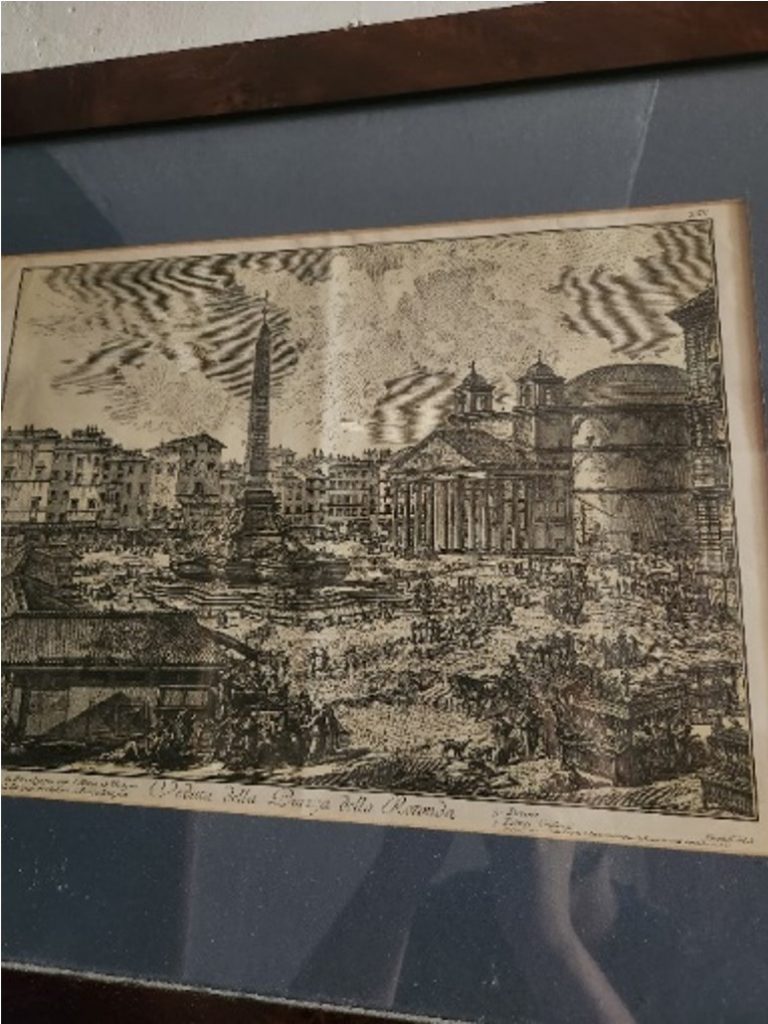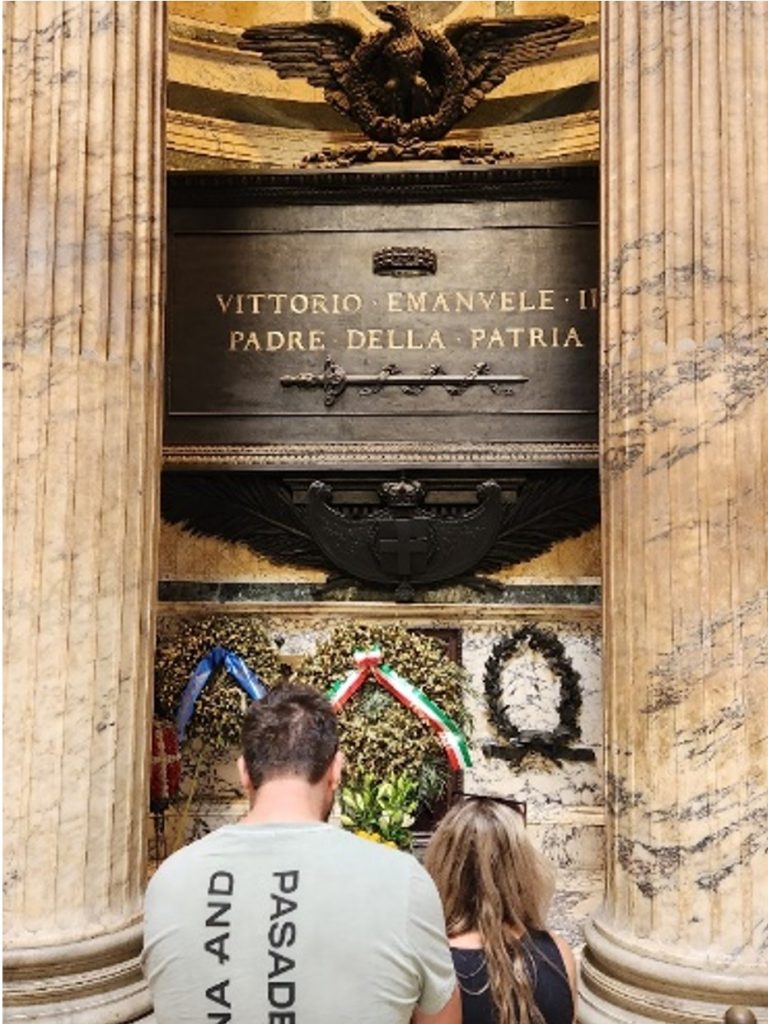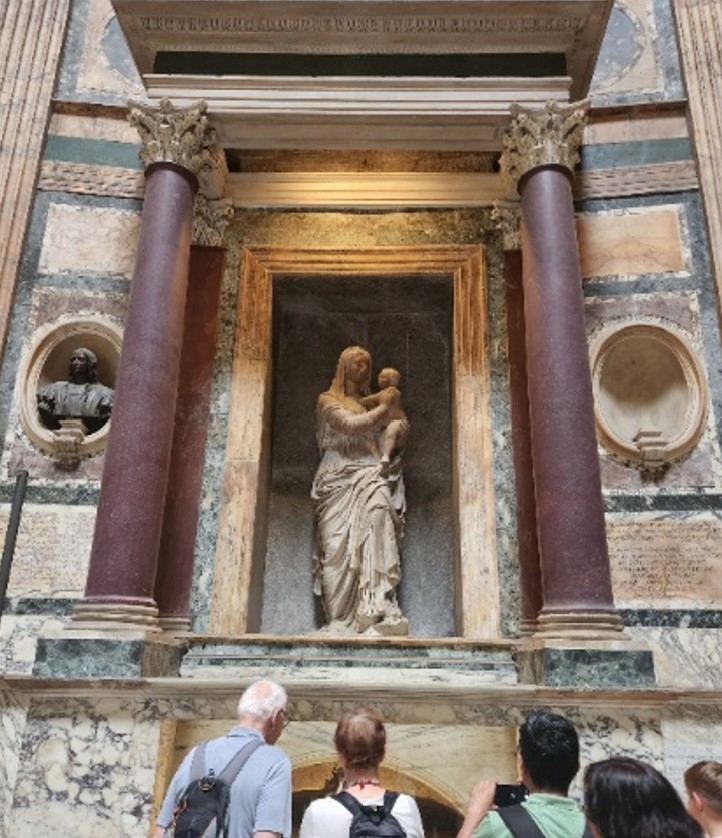Tags
Ancient Rome, BGSU History, BGSU Study Abroad, Casey Stark, HIST 3445, Jo Enger Arthur Scholarship for Study Abroad, Joseph DeSario, Roma Aeterna, Study Abroad Italy, Undergraduate
By: Joseph DeSario, BGSU Roma Aeterna 2023 Student
This is a presentation written as part of HIST 3445, Ancient Rome BGSU, Summer 2023 Roma Aeterna Education Abroad Program in Rome, Italy.
The Pantheon is regarded as one of Rome’s great tourist attractions due to its ancient history and architectural design. Many of those tourists do not know its origins of who built the Pantheon, why they built it, and why it still stands where it was built. The Pantheon was not always in the orientation as it is today and was built three times under three different emperors. To know why the Pantheon is regarded as one of the greatest structures that withstood the test of time people need to understand the origins and the purpose of the building, the architectural genius, the conversion of the Pantheon into a Church, its preservation, and its cultural importance and tourist appeal. The Pantheon began as a pagan temple that was rebuilt multiple times and was transformed into a Christian church, which shows cultural and religious evolution, which makes the Pantheon a major source of understanding the ancient world and a long-lasting mark of historical and architectural importance.

For people to understand the great significance of the Pantheon they must study its history and the origins of why it was built and for what purpose the building served to the ancient Romans. The Pantheon was not always in the position it is today nor was it as large as it is today, the initial structure was built under Agrippa and had a different orientation. “Lanciani’s reconstruction of a southern exposure was based on a misinterpretation of the archeological evidence, misreading the foundations discovered under the northern edge of Hadrian’s Pantheon as the back wall of Agrippa’s structure.”[1] The original Pantheon was facing in the opposite direction compared to the modern Pantheon built under Hadrian. Not only was Agrippa’s pantheon facing north it was also smaller than Hadrian’s reconstruction of the Pantheon and built on different foundations. “It has been proved by brick examination that the existing temple, including the pronaos, it is not that of Agrippa, but a new one, designed by Hadrian, on a larger scale and on different lines.”[2] The purpose of Agrippa’s Pantheon was to be a temple for all the gods so that Romans could worship different gods in one space and the Pantheon also has significance as to where it was built. According to Cassius Dio “It has this name, perhaps because it received among the images which decorated it the statues of many gods, including Mars and Venus; but in my own opinion of the name is that, because of its vaulted roof, it resembles the heavens.” [3] The purpose of the Pantheon does not change until the Christians take control of the Pantheon and turn it into a Christian Church. “Agrippa’s Pantheon also burned down in a fire in 80, to which during the reign of Domitian the Pantheon would be Rebuilt and set on fire from a bolt of lightning in 110.” [4] After the Pantheon was rebuilt by Hadrian, the Christians would turn the building into a church and take care of the building up to the present day.
The Christians played a significant role in allowing the Pantheon to evolve and change culturally and historically by being transformed in the Santa Maria and Martyrs Church. As the temple was originally meant for all gods the Christians found justification for turning thePantheon into a church because their god is one god over everyone. “It survived into the seventh century in good structural condition, inviting its consecration as a Christian Church.”[1] The Christians took the Pantheon and made it into a church with a legend behind the name which is the main factor of this ancient structure’s survival. They dedicated the church “in 609 to Santa Maria ad Martyres—there was a legend that some 28 wagonloads of martyrs’ bones had been transferred here from the catacombs.”[1]

The church was also used throughout the middle-ages and Renaissance as a fortress for protection against rival families vying for power in Rome. With two families in particular the Colonna and the Orsini. “When the popes took up residence in Avignon, the Pantheon served as a fortress in the struggles between the rival Roman aristocratic families of the Colonna and the Orsini.”[2] These families allowed the Pantheon to be protected through the Middle Ages, and in the Renaissance, the people started to admire The Pantheon as a great building to be reborn as Ancient Rome had a large influence during the Renaissance. “Under Pope Pius IV the bronze door was recast (1563) and Pope Urban VIII unwisely commissioned Bernini to add two bell towers in front: the Romans felt they looked clumsy and called them ‘Ass-ears of Bernini’.”[3]
Throughout the Renaissance, popes would continue to adapt and change the Pantheon as they saw fit without changing the structure by adding small editions like pillars or making changes to the Piazza Della Rotunda to make the Pantheon look better. The bell towers were not removed until after the Unification of Italy in 1861 and were removed in 1883. By learning about the Christian control of the Pantheon people can learn about the evolution of the Pantheon and the many changes it went through and how it was used. It also helps people understand why the Pantheon is one of the oldest surviving structures from the ancient period. The Christians kept the Pantheon intact for many years because the structure in general is an architectural masterpiece which is another reason people are still drawn to the structure to see the artisanship of the Ancient Romans.
The Pantheon is also an architectural marvel which was built using the fundamentals of Aqueduct construction to create a dome that is the largest in the world and creates a perfect circle on the inside of the structure. The sun was a key factor in the design of the Pantheon but first people need to understand how the Pantheon was constructed to see why it works as a building. “It is composed of a rectangular portico with three lines of granite columns fronting the circular building which is designed as a dome (43.3m Diameter), built over a cylinder of the same diameter as high as the radius creating a perfect circle with the oculus at the top that is 8.3m wide.”[1] The purpose of the oculus is to allow natural light into the building and has many uses for the church and the Ancient Romans. The Pantheon was placed specifically in the orientation to allow sunlight to enter the temple every day of the year. “Temples were usually orientated within the arc from the winter solstice sunrise to due south; therefore, direct sunlight could enter every day of the year in all such temples.”[1]
This oculus and construction of the Pantheon show the genius of Roman Architects and builders as they knew where to place temples to allow natural sunlight to enter the temples year round so, they were never in darkness. The temple was not only illuminated year-round people could also use the Pantheon as a sundial to keep time which shows how advanced the Romans were to build a structure such as the Pantheon because it was not just for looks and worship. “After a few visits to the monument on sunny days in different periods of the year, people acquire a rough ability to know the day of the year and the hour of the day by looking at the position of the sunbeam.”[2] Further showing the Pantheon is an architectural marvel which allows people to have a better understanding of the ancient world and why it is such a popular destination for tourists as it not only draws historians, religious people it also draws architects and people who want to pay respects for the people buried in the Pantheon.
The Pantheon is also a tourist destination that appeals to many people from all over the world because it is also a pilgrimage site for religious people and Italians who wish to pay respects to the first two kings of Italy and the famous painter Raphael who are buried in the Pantheon. “Raphael was the first person to be buried in the Pantheon, on his specific request: he died in 1520 aged only 37.”[3] Raphael was a great artist and respected by the Popes who allowed him to be buried there and is one of the many people buried there that many tourists want to see because of his amazing work during the Renaissance. Also buried in the Pantheon are the kings of Italy after the Unification of the country after the Risorgimento. “The first two kings of Italy lie opposite of each other: Vittorio Emanuele II, who died on 9th January 1878; and King Umberto I, assassinated at Monza on 29th July 1900 with the first queen of Italy Margherita of Savoy.”[1]

The Pantheon also draws Christians from all over the world as it is a Christian church to which people can visit and pray in when the doors are open which allows people to appreciate the Ancient Romans and the Christians who decorated the Pantheon with art and allowed great people to be buried due to the respect that the Italian people had for the dead who are buried at the church today. This is why people should continue to visit the Pantheon to continue its legacy for future generations and to learn about the evolution of the Pantheon so other tourists can enjoy the impressive structure.

The Pantheon was once a great Ancient Roman Pagan temple that was rebuilt under Hadrian to allow people to worship all gods because that was the purpose of the Pantheon. The Pantheon was a work of architectural genius, overtime the Christians took the Pantheon and allowed the structure to evolve religiously and culturally through many years of constant use which allowed the Pantheon to be a reliable source for understanding the ancient world leaving a mark on history and Architecture. The Pantheon withstood the test of time through the Middle Ages where popes would adapt and change the Piazza Della Rotunda to fit their visions, it was also used for protection against rival political families in Rome hoping to gain power. This is why tourists should learn about the history of the Pantheon to understand why it became a tourist attraction in the first place. Once Learning about the Origins of the building, why it survived when the Christians turned the Pantheon into Santa Maria and Martyrs Church, and why Architects study the great structure as forms a perfect circle. This structure also had uses for the famous dome and Oculus for Romans to tell time which shows how advanced Roman Thinking was when the Pantheon was built.
Bibliography
Dio, Cassius. 1917. Roman History. Translated by Earnest Cary. Harvard University Press. Cassius Dio, Roman History 53 (lexundria.com).
Edmund, Thomas. “The Cult Statues of the Pantheon.” The Journal of Roman Studies 107, (2008): 146-212. Accessed June 21, 2023. https://doi.org/https://www.jstor.org/stable/26576049.
Hannah, Robert, and Giulio Magli. “The Role of the Sun in the Pantheon’s Design and Meaning.” Numen 58, no. 4 (2011): 486-513. Accessed June 21, 2023. https://doi.org/http://www.jstor.org/stable/23045866.
Macadam, Alta, and Annabel Barber. 2020. Blue Guide Rome: Twelfth Edition. 12th ed. Blue Guides.
Phillips, Darryl A. “The Civic Function of Agrippa’s Pantheon.” Latomus 75, no. 3 (2012): 650-676. Accessed June 21, 2023. https://doi.org/https://www.jstor.org/stable/48620026.
